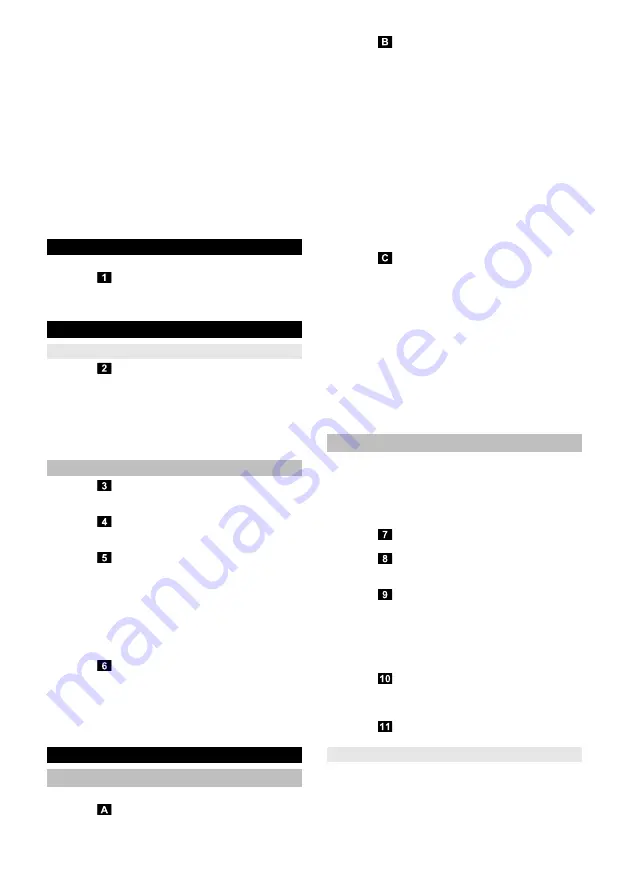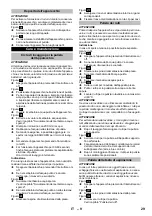
– 7
* FC 5
** FC 5 Premium
Illustrations on the picture pages
Illustration
Insert handle into the basic unit as far as it goes un-
til it engages audibly.
The handle must sit snugly into the appliance.
Illustration
Screw the cleaning rollers onto the threaded rod up
to the mechanical stop.
Pay attention to the colour-codes on the inside of
the roller and roller holder on the appliance (e.g.
blue should match up with blue).
After the installation, check to ensure that the
cleaning rollers sit snugly.
Illustration
To stabilise, place the appliance into the cleaning
station.
Illustration
Remove the fresh water tank from the appliance
using the handle.
Illustration
Open fuel filler cap.
Fill the fresh water tank with cold or lukewarm tap
water.
KÄRCHER detergents/care agents can also be
added to the fresh water tank as required.*
See chapter "Detergents and care products".
Do not exceed the "MAX" marking when filling.
Close tank lock.
Illustration
Insert the fresh water container into the appliance.
The fresh water tank must sit snugly into the appli-
ance.
ATTENTION
*Follow the recommended dosage instructions on the
detergent/care agent.
ATTENTION
Illustration
The appliance must only be used for the intake of dirt
and fluids (max. 250 ml).
Illustration
Before beginning your work, remove any objects, such
as shards, pebbles, screws or toy parts from the floor.
Before use, check the floor for water consistency at sus-
pect areas. Do not clean water-sensitive coatings, such
as untreated cork floors (moisture ingress is possible
which may damage the floor).
Notes
To avoid striped patterns, test the device on an in-
conspicuous area before using on sensitive surfac-
es, e.g. wood or fine stone.
Don't stay in one place, keep moving.
Follow the instructions of the floor covering manu-
facturer.
Notes
To prevent yourself from tripping over network cables,
keep the handle in one hand, and the network cable in
the other.
Illustration
To avoid fresh footprints on the freshly-wiped floor, work
backwards towards the door.
Hold the appliance at the handle at angle of approx.
60 degrees.
Clean the floor by moving the appliance back and
forth at a similar speed as if you were vacuum
cleaning.
If the floor is especially dirty, let the appliance glide
slowly across the floor.
For scope of delivery of the roller pads in grey and
yellow: Both roller pads have the same functionali-
ty, they can be used for different areas of applica-
tion (colour distinction, e.g. for kitchen and bath-
room).
ATTENTION
After switching on the appliance, the cleaning rollers will
begin to rotate. Hold the handle tight to prevent the ap-
pliance from moving forwards by itself.
Make sure the fresh water tank is filled with water and
the waste water tank is fitted in the appliance.
Illustration
Insert the mains plug into a socket.
Illustration
To quickly wet the rollers, use a measuring cup to
fill the cleaning station with 50 ml of fresh water.
Illustration
Switch on the appliance and put it into operation in
the station for 5 seconds.
The appliance then has the ideal level of moisture
in order to allow fast cleaning.
Switch off the appliance; press the on/off button to
do so.
Illustration
Remove the carrying handle from the cleaning sta-
tion and set it on the floor.
Hold the appliance firmly using the handle.
Illustration
To switch on the appliance press the on/off switch.
ATTENTION
Before filling the fresh water tank, please empty the
waste water tank. In this way you can avoid overflowing
of the waste water tank.
See Chapter "Emptying the waste water tank".
11
Cover suction head
12
Lock suction head
13
Fresh water tank
14
Handle fresh water tank
15
Cleaning / park station
16
Roller storage
(depending on model)
17
Filter inlay
18 * Detergent
RM 536
30 ml
19 ** Detergent
RM 534
30 ml
20 ** Detergent
RM 536
500 ml
10 ** Cleaning rollers
2x
Assembly
Commissioning
Installing the rollers
Fill fresh water reservoir
Operation
General information on the operation
Start working
Refill detergent
14
EN
Summary of Contents for FC 5
Page 2: ...2...
Page 3: ...3...
Page 4: ...4...
Page 78: ...6 IEC 60364 FI 3x1 mm 78 EL...
Page 80: ...8 60 50 ml 5 n Off n Off MAX MAX n Off n Off 80 EL...
Page 81: ...9 n Off 200 ml K RCHER n Off 30 60 n Off n Off 60 C 81 EL...
Page 82: ...10 n Off n Off K RCHER MAX 10 20 82 EL...
Page 91: ...6 IEC 60364 FI 3x1 91 RU...
Page 93: ...8 K RCHER MAX 250 60 50 5 MAX MAX 93 RU...
Page 94: ...9 200 K RCHER 30 60 94 RU...
Page 95: ...10 60 C MAX 95 RU...
Page 96: ...11 10 20 15 50 90 96 RU...
Page 97: ...12 220 240 V 1 50 60 Hz IPX4 II 460 500 400 200 7 0 5 0 320 270 1220 97 RU...
Page 153: ...6 IEC 60364 3x1 0 C 153 BG...
Page 155: ...8 50 ml 5 MAX MAX 155 BG...
Page 156: ...9 200 ml K RCHER 30 60 60 C 156 BG...
Page 157: ...10 K RCHER MAX 10 20 157 BG...
Page 178: ...6 IEC 60364 F 3x1 178 UK...
Page 180: ...8 50 5 MAX MAX 180 UK...
Page 181: ...9 200 K RCHER 30 60 60 C 181 UK...
Page 182: ...10 MAX 10 20 15 50 182 UK...
Page 183: ...11 90 220 240 V 1 50 60 Hz IPX4 II 460 500 400 200 7 0 5 0 320 270 1220 183 UK...
Page 185: ...6 IEC 60364 FI 3x1 185 KK...
Page 187: ...8 60 50 5 MAX MAX 187 KK...
Page 188: ...9 200 K RCHER 30 60 60 C 188 KK...
Page 189: ...10 K RCHER MAX 10 20 189 KK...
Page 190: ...11 15 50 90 220 240 V 1 50 60 Hz IPX4 II 460 500 400 200 7 0 5 0 320 270 1220 190 KK...
Page 192: ...11 MAX 10 20 15 50 192 AR...
Page 193: ...10 60 193 AR...
Page 194: ...9 200 ON OFF 30 60 194 AR...
Page 195: ...8 60 50 5 ON OFF MAX MAX 195 AR...
Page 197: ...6 IEC 60364 FI 3x1 197 AR...
Page 199: ......












































